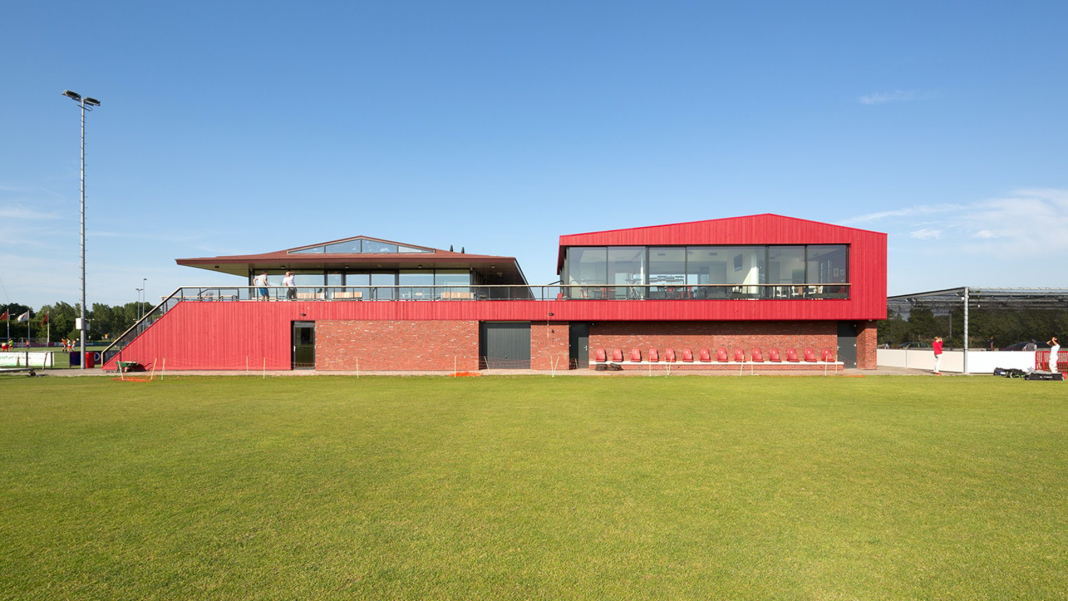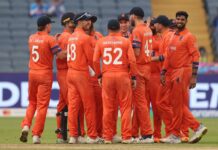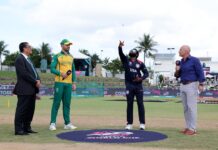At the close of what has arguably been the most successful year in the KNCB’s 140-year history, the Board of the Dutch governing body was able to face its members in good heart at its half-yearly general meeting in Amstelveen on Saturday.
It was not merely the fact that the men’s national team had brought its tally of victories over ICC Full members to five in the space of barely twelve months, although that achievement was given plenty of celebratory attention in the course of the meeting.
By contrast with its predecessor in April, a fractious, largely negative affair at which an inexperienced, underprepared Board saw its most significant proposals sent back to the drawing board, this was a confident, well-managed performance by chair Guido Landheer and his colleagues, and while there were warning notes of caution and an array of (often traditional) complaints, a broadly healthy financial situation, a clear-eyed annual plan, and even some fairly radical adjustments to the constitution generally won the approval of the assembled club representatives.
There was a gracious moment of reflection when Landheer paid tribute to the career of Mudassar Bukhari, who played for the Netherlands 185 times between 2007 and 2016 taking 246 wickets across all three formats and who retired from all cricket at the end of last season.
Although he was quite clearly trying to hit a rapidly-moving target, treasurer Mudi Allah Rakha was able to report that, largely because of the additional ICC grant which followed World Cup qualification, a budget deficit of €45k. in 2023 had been converted into a surplus of something in excess of €400k, although the final figure would not be known until the end of the current quarter.
Furthermore, it appeared that the uncertainties arising from the ICC’s new resource distribution model, which is designed to shovel an even bigger slice of the cake into the seemingly insatiable maw of the BCCI, had to a degree been alleviated by the profitability of the recent rights sales, which meant that the cake itself was significantly bigger.
While he had been budgetting for a 2024 deficit of nearly €300k., therefore, to be covered by this year’s surplus, it now appeared that when he brought the definitive budget to next April’s general meeting it would project a positive result.
There are, of course, many imponderables in such calculations, especially when ICC grants represent more than 60% of the KNCB’s income – although the very substantial increase in sponsorship which has resulted from the men’s team’s on-field successes, greater media coverage and a more nuanced KNCB strategy has encouraged the Board to project a further growth from that source next year to €948k., which would be a 67% increase on the 2023 figure and the first time in living memory that sponsorship had topped 20% of income.
This rose-tinted view triggered understandable warnings: how solid were the projections of the ICC grants, and what would happen if the sponsorship drive turned out to be less lucrative than hoped? And what about the longer-term perspective, especially for a year like 2025 when there was no World Cup to boost the income?
Landheer, Mudi and CEO Monica Visser were keen to still any mutterings, assuring the meeting that a range of scenarios were constantly being evaluated and revised, and that spending would be kept within the bounds of the available resources; with the watchful eyes of former chair Betty Timmer and former treasurer Amit Parulekar looking over their shoulders, they could hardly be expected to do anything else.
But words like ‘ambition’, ‘momentum’ and ‘buzz’ fall readily, and with good reason, from the Board’s lips, and the annual plan for 2024, building on what has already been achieved and looking forward into the medium term, gave the clubs plenty to chew on.
Chairman Landheer talked about four main areas of activity: high performance, where the aim is to secure a place for the Netherlands (or, presumably, at least for its men’s team) in the international Top Ten; development, where the goal is a 40% increase in playing numbers between 2021 and 2025 and where there has been a growth of more than 12% in 2023 alone; finance, where growth in sponsorship income promises to give the Bond more room for manoeuvre and reduce its dependence on the ICC; and the continuing transition of the KNCB’s operations ‘from governing body to Centre of Excellence’.
One of the most significant developments of the past twelve months has been what looks like a beginning of a reversal of the long decline of cricket outside the ‘Randstad’, the highly urbanised western area which extends from Amsterdam to Rotterdam, taking in Den Haag.
The emergence of new or revived clubs in Groningen in the far north to Maastricht in the extreme south, but also including Zoetermeer, Eindhoven and now, for the first time in Dutch cricket history, the town of Terneuzen, in that detached part of the Netherlands adjacent to Belgium, is a promising step towards Landheer’s declared aim of a cricket club in every major Dutch city and town, although there will inevitably be logistical issues for the most far-flung of these new clubs.
As far as the more established centres are concerned, attention will centre on women and youth, both areas where despite plenty of effort over recent years the numbers remain stubbornly low: male youth numbers have stayed at aound 1000, while female players in 2023 total fewer than 250 women and fewer than 150 girls.
A full-time project officer for women’s and youth cricket will be added to the strength in the New Year along with a fifth Regional Development Officer, and with former national women’s captain Helmien Rambaldo looking after the educational side and the appointment of a national women’s coach, a successor to Shane Dietz, currently in train, the Board is certainly committing its scarce resources to this priority area.
Which is not to say that the club representatives did not have plenty to offer: various speakers reinforced the need to do more for the development of players aged between 18 and 25, who tended to be neglected once they had graduated from the Dutch Lions (and Lionesses) programmes, pointed to the continuing underrepresentation of cricket’s ever-growing Asian community on the KNCB’s committees, and worried away at the vexed problem of ground availability, especially in the Greater Amsterdam region.
But for the Board, perhaps the greatest relief was the approval, without any dissent, of its proposed changes to the constitution and the Huishuidelijk Reglement (Rules and Regulations), which brought the KNCB into line with changes in the law and the requirements of the Dutch Olympic Committee NOC*NSF, as well as tidying up many administrative procedures.
One of the most interesting amendments is to the weighting of a card vote, where for the first time the number of youth teams run by a club will be taken into account in working out how many votes it has, alongside its senior teams.
There will also be a new category of extraordinary individual membership, likely to be employed very rarely; this had been the most contentious item in April, but the Board had in the meanwhile drawn its teeth by specifying that such members, while they might fulfil elected functions within the Bond, would not themselves have a vote at general meetings.
If only all the KNCB’s problems could be so readily resolved!
You’re reading Emerging Cricket — brought to you by a passionate group of volunteers with a vision for cricket to be a truly global sport, and a mission to inspire passion to grow the game.
Be sure to check out our homepage for all the latest news, please subscribe for regular updates, and follow EC on Twitter, Facebook, LinkedIn and YouTube.
Don’t know where to start? Check out our features list, country profiles, and subscribe to our podcast. Support us from US$2 a month — and get exclusive benefits, by becoming an EC Patron.







